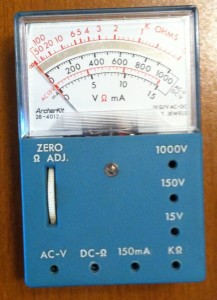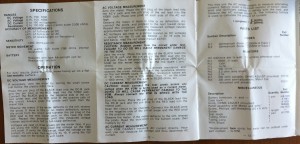I don’t know whether it’s sentimentality or practicality – or maybe both – but I love Radio Shack. While there are stores and/or online vendors who offer a wider assortment of embedded devices and electronic components, their Radio Shack stores are everywhere, and the selection is good. And although the prices are higher than ordering directly from China, I can have a part or board in hand in 15 minutes if Radio Shack carries it. You’re buying the item + unbeatable convenience, and all things considered, it’s a pretty great deal.
Years ago, I bought a little multimeter kit from Radio Shack. I needed a multimeter, and I kind of wanted to “build it myself”. The ArcherKits are easy to assemble, with just enough soldering and small work to give you immense satisfaction every time you use it. 🙂
I’ve since upgraded multimeters to a nice digital model, but you know what I keep in my embedded device toolbox? My trusty old analog ArcherKit multimeter. It’s not fancy, but it’s nearly indestructible and it just works.
Just today, I couldn’t remember how to take a measurement that I rarely have call to make, and when I went to look for the operator’s manual, I couldn’t find it. Searching online didn’t help, either. I finally did locate it…but it occurred to me that others may find themselves in the same bind. And no one should have a great tool without having the instructions handy. So…below is a snapshot of the basic foldout of operating instructions. Simple, straightforward, and essential!
If you have an ArcherKit 28-4012A multimeter, I hope you’re still enjoying it as much as I am. When absolute digital precision is required, this little guy gets a well-deserved rest…but guess what sees the most action? 😉
Keep MAKING,
Mark
Related Posts:
Tags: 28-4012A, ArcherKit, instruction, manual, multimeter, operating, Radio, Shack




“Analog” multimeters serve a purpose that is difficult to duplicate with digital devices: taking measurements while adjusting something for a peak or null setting.
There is a lot about the bygone days of electronics that I miss: the dip-and-tune process for tuning a tube operated transmitter, and the distinct aroma of hot vacuum tubes are at the top of that list.
Too true. I do think that people are beginning to realize that “new” doesn’t always equal “better”, and using the right tool (even if “old tech”) makes life easier – and often, just more enjoyable! Nail guns didn’t do away with hammers, either. 🙂
Really glad to see the “Maker renaissance” in full swing. The more people who are infected with that bug, the more “normal” it becomes… 😉
Mark
Wow, when did you buy that? It must be from the 70s or so.
Believe it or not, I bought the kit in 1988! Those little kits had staying power, probably because they’re fun, quickly useful, and nearly indestructible. I still use mine to this day, and (as I think I mentioned in the article but can’t remember for certain), I do have a really nice digital MM. There’s room in my toolbox for both. 😀
Great to hear from you, George!
All the best,
Mark
I have one of these and it has shared space in many of my toolboxes over the years. It’s everything you say and just keeps on working. I probably built mine in the late 70’s but I think I also remember having one in my college years back in the 60’s. Not sure about that though. I’ve got other multimeters, but not necessarily better for quick and dirty everyday measurements.